|
Should
the First Australian Victoria Cross be awarded to the man with the donkey?
Before
you answer read this story on the life of
The
Man with the Donkey.
Two
recommendations for The Empire’s highest award, The Victoria Cross, and
one for the Distinguished Conduct Medal, were denied the man who was
thought of as a hero, by both Officers and men who knew him on Gallipoli.
 |

|
| His
Service Medals: 1914/15
Star (13980), The
British War Medal (2715),
The Victory Medal with Mentioned in Despatches Oak-leaf (MID) (2715) were issued and
inscribed by Australia House, London 29 December 1919.
They are now on display at the Australian War Memorial,
Canberra. |
ANZAC
Medallion. (1967)
Simpson got #1
|
| The Memorial Plaque (Deadman's
Penny) issued to the family of John Simpson (Kirkpatrick). |
 |
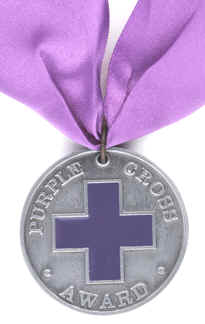 |
Metal with 'antique silver' finish;
Enamel; Royal Society for the Prevention of Cruelty to Animals
Purple Cross and framed certificate of award.
Antique silver medal bear a purple enamel cross on
the obverse with the embossed words, 'PURPLE CROSS AWARD'. Reverse
shows 'RSPCA' and paw print logo, and is engraved 'Simpson's Donkey
"Murphy".
Awarded posthumously to Simpson's donkey 'Murphy'.
Certificate further states, 'and for all the donkeys used by John
Simpson Kirkpatrick, for the exceptional work they performed on
behalf of humans while under continual fire at Gallipoli during
World War I (1915)'.
Presented to the Australian War Memorial at a
ceremony on 19 May 1997. |
A
combination of both red tape and bungling have for eighty seven years,
denied John Simpson due recognition. The Gallipoli Hero, who with his
donkeys, brought in to the aid station on the beach at Gallipoli more than
three hundred wounded men, has been depicted on Australia’s Stamps,
Coins and Banknotes. There
are five sculpture’s of Simpson in Australia, one by W Anderson “Man
with the Donkey” near the Shrine of Remembrance in Melbourne, which was
unveiled by Lord Huntingfield Sat 20 June 1936.
Another is near the entrance of the Australian War Memorial in
Canberra.
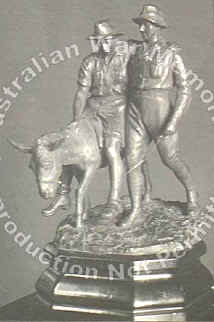 |
A photograph of a statuette of 202 Private J.S.
Kirkpatrick (who served in the 3rd Australian Field Ambulance, AIF
as John Simpson), who became known as "The man with the
donkey".
The statuette shows Simpson evacuating a wounded
soldier on a donkey. (Donor The Librarian, South Shields)
Should
this English born Scot now be the first man to be awarded The Australian
Victoria Cross? |
Following
his death, he was twice recommended for the Victoria Cross, firstly by the
Commander of the 4th Brigade who he had been working with, Colonel (later
General Sir John) Monash,
and then by his own unit on 3 June 1915.
In addition Lieutenant-Colonel Sutton had earlier recommended him
for the Distinguished Conduct Medal on 24 May.
Fifty
three years later, 1967 Australia’s then serving Prime Minister Harold
Holt and the Governor General combined and petitioned the British War
Office seeking to have Pte Simpson awarded the Victoria Cross.
The request was denied on the grounds that the granting of the
Victoria Cross to Simpson would set a dangerous precedent.
Those
making this decision ignored the fact that a precedent had been set in
1907 when Lieutenant’s Melvill and Coghill had been awarded posthumous
Victoria Crosses for their actions in South Africa 28 years earlier. John
Simpson Kirkpatrick was born at 10 South Eldon Street, South Shields,
Tyneside, Durham, in the North East of England 6 July 1892, one of eight
children born to Scottish couple, Robert and Sarah Kirkpatrick, who had
moved to Tyneside in 1886.
| Gallipoli
Peninsula, Turkey. Australian graves on
a hillside at Anzac. 202 Private John (Jack) Simpson Kirkpatrick
(who enlisted as John Simpson), 3rd Field Ambulance, who was killed
19 May 1915, is buried in Hell Spit Cemetery and commemorated by the
central cross. (lent by: Lieutenant
J. Stubbs) |
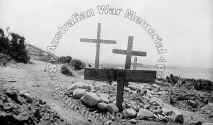 |
‘Jack’
was educated at Mortimer Road School, and during school holidays he worked
at Murphy’s Fair, for Mr George as a donkey-lad, where he was in charge
of several donkeys with which he used to take children for a ride on Herd
Sands beach. By 1900 four of his siblings had died, three brothers and a
sister. Four years later his
father Robert Kirkpatrick, the Captain of a collier was badly injured in
an accident. This left Jack the man of the house at twelve years of age.
The
family moved to 14 Bertram Street South Shields and on leaving school Jack
gained employment with Mr Fred Patterson delivering the daily milk supply
to the local residents. Robert
Kirkpatrick died October 1909, two days later Jack then aged 17 went to
sea as a storeman onboard SS Heighington, returning home to England, where
he was paid off just in time to celebrate Christmas with his Mother and
his three surviving sisters.
On
12 February 1910 he joined SS Yedda as a stoker sailing for South America
and Newcastle, New South Wales, Australia.
Such was the state of the Yedda that on arrival in Newcastle, Jack
and thirteen other crewmen jumped ship.
He
then tried many occupations, Cane cutting in North Queensland, Droving and
Jackarooing in Central Queensland, Coal Mining at Corrimal, NSW, and Gold
Mining in Western Australia before returning to sea for the next two and a
half years as a stoker onboard Kooringa.
Sailing from Geraldton in Western Australia to Newcastle in New
South Wales.
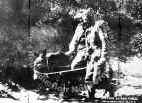 |
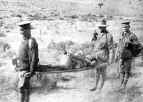 |
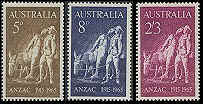 |
| Simpson
at work |
How
other Bearers worked |
Aussie
stamps with Simpson |
Sick
of life at sea, he found accommodation at 616 Bourke Street, West
Melbourne. Then later while
living at 330 Raglin Street, Port Melbourne he was ill for three months
with influenza. Realizing
life at sea wasn’t too bad he sailed once again as a stoker onboard SS
Tarcoola on New Years eve, following an argument with the chief he wrote
home saying he was coming home later in the year.
He then transferred to SS Yankalilla which was working solely off
the Western Australian coast, three weeks later when they returned to
Perth Jack was surprised to learn that England and Germany were at War.
 |
Once
again he jumped ship, enlisting in the AIF on 23 August 1914 under the
name of John Simpson.
His
attestation papers show he listing his previous military experience as
twelve months with 4th Durham Territorial’s (equivalent to CMF or Army
Reserve).
He was a 22 years
and 2 months old Protestant, 5 foot, 8 ½ inches tall, weighing 12 stone.
To the memory of our hero comrade 'Murphy'
(Simpson) killed May 1915.
John (Murphy) Simpson Kirkpatrick leading a donkey
along a cliff path. (Actually it is Pte
Henderson NZEF)
A wounded soldier is on the donkey.
By Horace Millichamp Moore-Jones.
 SEE THE
UNTOLD STORY
SEE THE
UNTOLD STORY
|
| Image
above left: Depicts Private John Simpson Kirkpatrick of the 3rd
Australian Field Ambulance and his donkey, 'Murphy'. Kirkpatrick
is shown as a full-length figure, moving forwards along a cliff
edge, suppporting a wounded soldier seated on his donkey. Later
research undertaken by the Australian War Memorial suggests that
the watercolour was copied by Moore-Jones from a photograph of a
stretcher-bearer with the New Zealand Medical Corps, Richard
Alexander Henderson. This work was reproduced by the British
Historical Section (Military Branch) of the Committee of Imperial
Defence, London, in July 1926. It was owned by the Commonwealth
Government in London and then came back to Australia during the
1960s, where it became property of the Prime Minister's Department
and from there entered the National Gallery of Australia's
collections during the 1980s. The painting was presented to the
Commonwealth Government through Sir John McEwan. |
After
a medical at Francis Street, Perth, he was accepted into the Army,
allocated as a stretcher-bearer with “C” section of the 3rd Field
Ambulance, with the 1st Division of the AIF. He went into training at Blackboy Hill camp, 35 km from
Perth.
He
allocated 4/- a day from his 6/- (60 cents) a day army pay to his mother
who was still in England. Directing
her to take half towards household expenses and bank the other half for
him to collect after he, “had a good holiday in the Army”, believing
he would be sent to Aldershot in England to train. He like many at that time, was of the opinion that the war
would be over by the end of the year.
On
Christmas Day Jack wrote and told his mother, that he had been looking
forward to spending this day with her at Shields, while adding that he
would not have enlisted in Australia if he had known at the time what lay
ahead. Instead he would have
worked his way home and then after a holiday, enlisted in England.
During
the four years he had been away from home, no matter what the state of his
finances, he had always managed to send his mother three pounds (6
dollars) a month. Embarking from Fremantle on board the 12,032 ton former
Oceanic SN Co Ltd vessel His Majesties Australian Transport A7.
“Medic.” Which the Australian government had requisitioned to help
transport the AIF overseas.
The
troops onboard “Medic” learnt on 2 November that England had declared
war on Turkey, before they joined with the First Contingent of Australian
and New Zealand troops, who were onboard 36 transports. The
Convoy made up of converted passenger and cargo ships carried 20,758
members of the First A.I.F. and 7, 479 Horses. It had sailed from King
Georges Sound on 1 November, escorted by the Australian light cruisers
H.M.A.S. Sydney and H.M.A.S. Melbourne, a armed merchant cruiser H.M.S
Orvieto and a Japanese cruiser.
Five
days out they passed the mail steamer Osterley, which reported its narrow
escape from the German raider, Emden.
Four days later they watched as the Sydney sailed off under full
steam to intercept the Emden, which was attacking a wireless station at
Cocos Island.
The
H.M.A.S. Sydney in what was the first action of the war by the Royal
Australian Navy, in a ninety minute battle out manoeuvred the Emden which
it disabled before running it aground on the North Keeling Island reef.
Crossing the equator on November 12, the Convoy arrived at their first
port of call, Colombo, where escort duty was taken over by a single ship
H.M.A.S. Hampshire. Before
arriving in Colombo 329 men had been treated by the ship’s hospitals, 62
had measles and 55 Influenza.
H.M.A.S.
Hampshire. left the convoy 24 November, the next evening the convoy
arrived at Aden, where they stayed overnight leaving 6 am 26 November
staying very close to the Arabian Coast, till they reached Port Suez, on 1
December, where they received definite orders to disembark and train in
Egypt. The troops were now
finding the nights very cold.
The
SS Medic arrived Cairo 12 December after a 42 day journey.
Here Jack boarded a train for the 20 km journey to Mena, where the
Australians set up a training camp. Mena was a village located in the
shadows of the Sphinx and two Pyramids. Here they joined with English and
Indian troops.
At
the end of February Jack Simpson placed his pet possum which he had
brought from Australia with him in the Giza Zoo, before he left for the
Lemnos Island. Where the 3rd
Field Ambulance trained for seven weeks, while training on Lemnos Jack
registered his will in which he left his entire estate to his Mother.
On
15 April the 3rd Field Ambulance boarded the troopship “Devanha”
in preparation of the planned attack on the Dardanelles. In
order to get into the boat to be rowed ashore at Gallipoli, the men of the
3rd Field Ambulance first had to remove the dead and wounded that remained
in the boat from its previous trip to the beach.
Their
boat carrying 25 men was towed to within 300yards of the shore, from there
they had to row, grounded some distance from the beach, Jack acting
quickly was the second man to jump into the water to wade ashore 300mt
north of Ari Burnu Point, casualties were high during the landing with 3
Stretcher Bearers from the 3rd Field Ambulance being killed and 14
wounded.
Jack
soon realized that things had gone terribly wrong, they had been landed at
the spot that previously had been agreed was the landing site least likely
to succeed. Two
thousand of the Men who landed on the 25th April were casualties by night
fall. Despite this by 2am on
the 26th due to the efforts of Field Ambulance Brigades all the wounded
were safely on the hospital ships.
But
the stretchers use to transport the wounded to the hospital ships were not
being returned leaving the stretcher-bearers not only short in number, but
without stretchers. Instead
of the stretcher bearers working in teams of six as they had trained, they
were required to work either with a mate or on their own.
On the second day after single-handedly carrying back several
wounded, Jack about to place another man on his broad shoulders when he
saw a abandoned donkey standing nearby.
He
quickly made a halter from bandages, put the wounded man on the donkeys
back and a legend had been born. Jack's actions were officially frowned upon but inwardly admired by his
superiors, but after four days of not returning to his unit, he was for
all intents and purposes a deserter.
He had formed himself into a one man unit.
During
these four days Jack and the donkey had been working eighteen hour days,
taking water from the beach to the men in the trenches, before returning,
bringing the grateful wounded, through Monash Valley to the beach where
they could be treated.
Anxious
about lack of proper food for the donkey, jack teamed up with the 21st
Kohat Indian Mountain Artillery Battery who came to know him as
“Bahadur” the “Bravest of the Brave”. With
the Indians he was able to spell his donkey using others that the Indians
had brought to move their cannons around, these donkeys “Murphy”,
“Abdul”, “Duffy” and “Queen Elizabeth” were then used one at a
time by Jack to continue his work.
| webmasters
note. I have read dozens of reports of Simpson's efforts. Some but
not many mention that he carried water forward to the troops after
dropping the wounded at the CCS. It adds to the legend of the
man's activities even if it technically removed his claim to be a
non combatant. Aiding unwounded troops, although a wonderful thing
to do, removed any claim that he had to protection under the Red
Cross arm band. |
Despite
the many warnings regarding snipers, Jack displayed nerves of steel as he
went forward many times into no mans land to bring back wounded soldiers. The
Indians made him a saddle and bridle, and Jack progressively worked longer
hours, as much as 20 hours a day. Making
the 1½ (2.2km) trip from the beach to the trenches between twelve and
fifteen times per day.
Toward
the end of the first week on Gallipoli one of Jacks passengers was a badly
wounded semi conscious English lad Billy Lowes.
Neither Billy who lapsed in and out of consciousness,
nor Jack who had to hold him securely on the donkey recognized each
other, as the mate they had traded rabbits with back at Shields many years
earlier.
Returned
home and discharged Billy Lowes, now aware of who his benefactor was,
contacted Jack's mother and sister and told them of his admiration and his
debt to the Man with the Donkey. After
24 days on Gallipoli Jack was killed on 19 May, when Turkish machine gun
bullets tore through his body, hitting him in the back and exiting through
the stomach. His donkey
continued to the beach with a critically wounded soldier on his back
before leading other concerned stretcher-bearers back to where Jacks body
lay.
Fearful
of the machine gunner they placed Jacks body behind a sandbag barricade,
leaving it there until 7pm that night when they carried him to the beach
and buried him at Hell Spit, later known as the Hillside Cemetery.
Which was at the southern end of ANZAC Cove, after a service
conducted by Rev J Green, they marked his grave with a simple wooden cross
bearing just two words “Jack Simpson”.
The
next day Colonel Monash put forward a lengthy submission to Divisional
Headquarters recommending Pte John Simpson for the award of a Victoria
Cross. A further
recommendation came from his unit 3 June, while Lieutenant Colonel Sutton
had earlier recommended that he receive a Distinguished Conduct Medal.
All
of these submissions failed. The bravery of Pte John Simpson Kirkpatrick has never been
duly recognized, apart from a special mention of his work between 25 April
and 5 May in Divisional orders No 60, on 14 March 1916.
When he was Mentioned in Despatches.
His Mother and sister Annie were notified of this 8 April 1916.
The
first his mother and sister knew of Jacks death was when a letter to Jack
from his sister Annie, was returned unopened with the word “Killed”
written on the front of the envelope. Colonel Howse VC, the Senior Medical
Officer on ANZAC (and Australia's first ever VC) was of the belief that
the Victoria Cross should not go to a stretcher-bearer for simply doing
his job. Many
blame the way in which Howse submitted Monash’s request for its failure.
This
was despite the fact that the first Victoria Cross awarded on Gallipoli
had been awarded to a British Stretcher Bearer L/Cpl W R Parker who on 1
May 1915 had helped rescue some wounded men from a trench despite being
wounded himself.
Nobody
denies Parker his VC, but it must be remembered that during his 24 days on
Gallipoli, Jack Simpson had with the aid of only his donkey’s brought
over three hundred wounded men back to the beach for treatment, continuing
to work on days that other stretcher bearers were ordered to discontinue
their work due to the ferocity of the Turkish snipers.
Lieutenant
Colonel A. C. Fergusson DSO, Commander of the 21st Kohat Indian Mountain
Artillery Battery and his men took great care with Jacks final donkey
“Duffy” with the intention of presenting it to Australia, but this
kind act failed when the donkey was stolen from their camp at Mudros.
Captain
Fry the on 2 September 1915 wrote to Jack's sister Annie telling her of
Jack's bravery and the admiration of him that was felt by his comrades, he
explained that during the time that Jack was carrying out his rescue
missions through Schrapnell Valley the area was almost constantly exposed
to snipers and was continuously shelled.
He
told her of Jacks disregard for the dangers and his refusal at times of
great danger to obey orders and remain under cover, and how he was always
cheery, singing and whistling as he carried out his self imposed task.
After
the war a headstone was erected on Jack Simpson’s Grave.

There
are five statues of Private
John Simpson and his donkey scattered around Australia, the best known
stands at the entrance to the Australian War Memorial, Canberra. |